Zhuang Xiong
Highly Undersampled MRI Reconstruction via a Single Posterior Sampling of Diffusion Models
May 13, 2025Abstract:Incoherent k-space under-sampling and deep learning-based reconstruction methods have shown great success in accelerating MRI. However, the performance of most previous methods will degrade dramatically under high acceleration factors, e.g., 8$\times$ or higher. Recently, denoising diffusion models (DM) have demonstrated promising results in solving this issue; however, one major drawback of the DM methods is the long inference time due to a dramatic number of iterative reverse posterior sampling steps. In this work, a Single Step Diffusion Model-based reconstruction framework, namely SSDM-MRI, is proposed for restoring MRI images from highly undersampled k-space. The proposed method achieves one-step reconstruction by first training a conditional DM and then iteratively distilling this model. Comprehensive experiments were conducted on both publicly available fastMRI images and an in-house multi-echo GRE (QSM) subject. Overall, the results showed that SSDM-MRI outperformed other methods in terms of numerical metrics (PSNR and SSIM), qualitative error maps, image fine details, and latent susceptibility information hidden in MRI phase images. In addition, the reconstruction time for a 320*320 brain slice of SSDM-MRI is only 0.45 second, which is only comparable to that of a simple U-net, making it a highly effective solution for MRI reconstruction tasks.
IR2QSM: Quantitative Susceptibility Mapping via Deep Neural Networks with Iterative Reverse Concatenations and Recurrent Modules
Jun 18, 2024Abstract:Quantitative susceptibility mapping (QSM) is an MRI phase-based post-processing technique to extract the distribution of tissue susceptibilities, demonstrating significant potential in studying neurological diseases. However, the ill-conditioned nature of dipole inversion makes QSM reconstruction from the tissue field prone to noise and artifacts. In this work, we propose a novel deep learning-based IR2QSM method for QSM reconstruction. It is designed by iterating four times of a reverse concatenations and middle recurrent modules enhanced U-net, which could dramatically improve the efficiency of latent feature utilization. Simulated and in vivo experiments were conducted to compare IR2QSM with several traditional algorithms (MEDI and iLSQR) and state-of-the-art deep learning methods (U-net, xQSM, and LPCNN). The results indicated that IR2QSM was able to obtain QSM images with significantly increased accuracy and mitigated artifacts over other methods. Particularly, IR2QSM demonstrated on average the best NRMSE (27.59%) in simulated experiments, which is 15.48%, 7.86%, 17.24%, 9.26%, and 29.13% lower than iLSQR, MEDI, U-net, xQSM, LPCNN, respectively, and led to improved QSM results with fewer artifacts for the in vivo data.
QSMDiff: Unsupervised 3D Diffusion Models for Quantitative Susceptibility Mapping
Mar 21, 2024



Abstract:Quantitative Susceptibility Mapping (QSM) dipole inversion is an ill-posed inverse problem for quantifying magnetic susceptibility distributions from MRI tissue phases. While supervised deep learning methods have shown success in specific QSM tasks, their generalizability across different acquisition scenarios remains constrained. Recent developments in diffusion models have demonstrated potential for solving 2D medical imaging inverse problems. However, their application to 3D modalities, such as QSM, remains challenging due to high computational demands. In this work, we developed a 3D image patch-based diffusion model, namely QSMDiff, for robust QSM reconstruction across different scan parameters, alongside simultaneous super-resolution and image-denoising tasks. QSMDiff adopts unsupervised 3D image patch training and full-size measurement guidance during inference for controlled image generation. Evaluation on simulated and in-vivo human brains, using gradient-echo and echo-planar imaging sequences across different acquisition parameters, demonstrates superior performance. The method proposed in QSMDiff also holds promise for impacting other 3D medical imaging applications beyond QSM.
Fast Controllable Diffusion Models for Undersampled MRI Reconstruction
Dec 01, 2023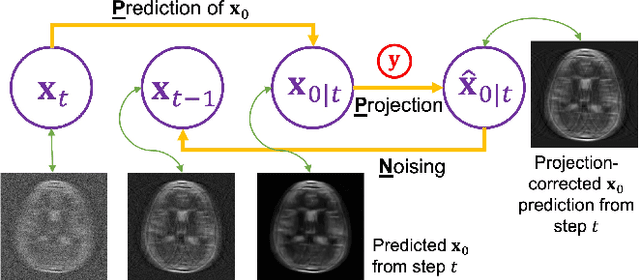



Abstract:Supervised deep learning methods have shown promise in undersampled Magnetic Resonance Imaging (MRI) reconstruction, but their requirement for paired data limits their generalizability to the diverse MRI acquisition parameters. Recently, unsupervised controllable generative diffusion models have been applied to undersampled MRI reconstruction, without paired data or model retraining for different MRI acquisitions. However, diffusion models are generally slow in sampling and state-of-the-art acceleration techniques can lead to sub-optimal results when directly applied to the controllable generation process. This study introduces a new algorithm called Predictor-Projector-Noisor (PPN), which enhances and accelerates controllable generation of diffusion models for undersampled MRI reconstruction. Our results demonstrate that PPN produces high-fidelity MR images that conform to undersampled k-space measurements with significantly shorter reconstruction time than other controllable sampling methods. In addition, the unsupervised PPN accelerated diffusion models are adaptable to different MRI acquisition parameters, making them more practical for clinical use than supervised learning techniques.
Plug-and-Play Latent Feature Editing for Orientation-Adaptive Quantitative Susceptibility Mapping Neural Networks
Nov 14, 2023Abstract:Quantitative susceptibility mapping (QSM) is a post-processing technique for deriving tissue magnetic susceptibility distribution from MRI phase measurements. Deep learning (DL) algorithms hold great potential for solving the ill-posed QSM reconstruction problem. However, a significant challenge facing current DL-QSM approaches is their limited adaptability to magnetic dipole field orientation variations during training and testing. In this work, we propose a novel Orientation-Adaptive Latent Feature Editing (OA-LFE) module to learn the encoding of acquisition orientation vectors and seamlessly integrate them into the latent features of deep networks. Importantly, it can be directly Plug-and-Play (PnP) into various existing DL-QSM architectures, enabling reconstructions of QSM from arbitrary magnetic dipole orientations. Its effectiveness is demonstrated by combining the OA-LFE module into our previously proposed phase-to-susceptibility single-step instant QSM (iQSM) network, which was initially tailored for pure-axial acquisitions. The proposed OA-LFE-empowered iQSM, which we refer to as iQSM+, is trained in a self-supervised manner on a specially-designed simulation brain dataset. Comprehensive experiments are conducted on simulated and in vivo human brain datasets, encompassing subjects ranging from healthy individuals to those with pathological conditions. These experiments involve various MRI platforms (3T and 7T) and aim to compare our proposed iQSM+ against several established QSM reconstruction frameworks, including the original iQSM. The iQSM+ yields QSM images with significantly improved accuracies and mitigates artifacts, surpassing other state-of-the-art DL-QSM algorithms.
Quantitative Susceptibility Mapping through Model-based Deep Image Prior (MoDIP)
Aug 18, 2023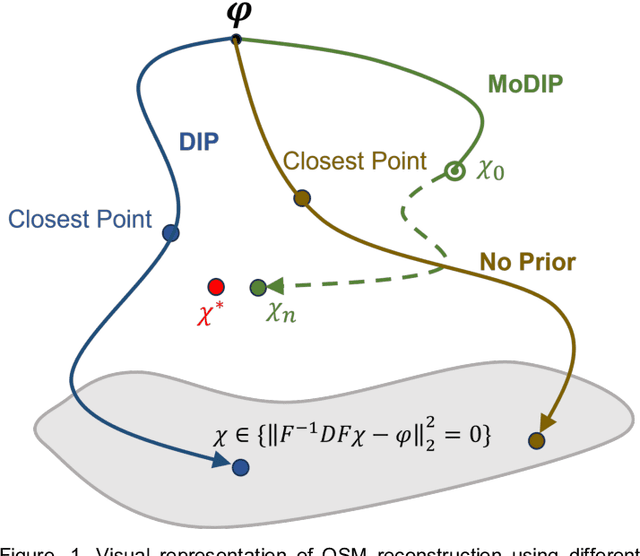
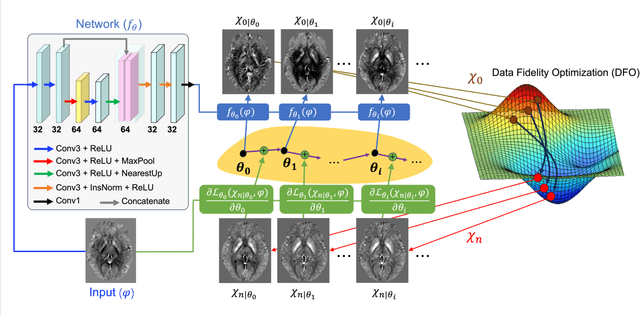
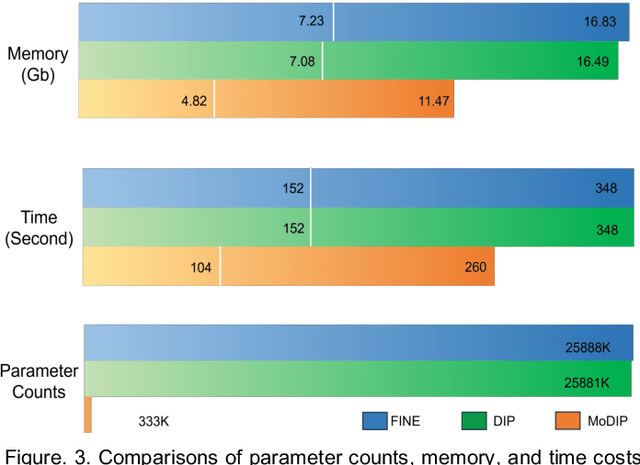
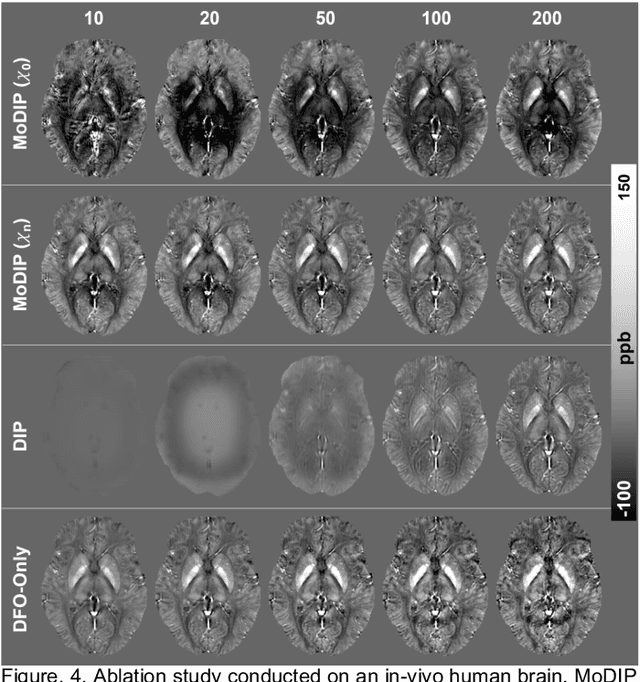
Abstract:The data-driven approach of supervised learning methods has limited applicability in solving dipole inversion in Quantitative Susceptibility Mapping (QSM) with varying scan parameters across different objects. To address this generalization issue in supervised QSM methods, we propose a novel training-free model-based unsupervised method called MoDIP (Model-based Deep Image Prior). MoDIP comprises a small, untrained network and a Data Fidelity Optimization (DFO) module. The network converges to an interim state, acting as an implicit prior for image regularization, while the optimization process enforces the physical model of QSM dipole inversion. Experimental results demonstrate MoDIP's excellent generalizability in solving QSM dipole inversion across different scan parameters. It exhibits robustness against pathological brain QSM, achieving over 32% accuracy improvement than supervised deep learning and traditional iterative methods. It is also 33% more computationally efficient and runs 4 times faster than conventional DIP-based approaches, enabling 3D high-resolution image reconstruction in under 4.5 minutes.
Affine Transformation Edited and Refined Deep Neural Network for Quantitative Susceptibility Mapping
Nov 25, 2022Abstract:Deep neural networks have demonstrated great potential in solving dipole inversion for Quantitative Susceptibility Mapping (QSM). However, the performances of most existing deep learning methods drastically degrade with mismatched sequence parameters such as acquisition orientation and spatial resolution. We propose an end-to-end AFfine Transformation Edited and Refined (AFTER) deep neural network for QSM, which is robust against arbitrary acquisition orientation and spatial resolution up to 0.6 mm isotropic at the finest. The AFTER-QSM neural network starts with a forward affine transformation layer, followed by an Unet for dipole inversion, then an inverse affine transformation layer, followed by a Residual Dense Network (RDN) for QSM refinement. Simulation and in-vivo experiments demonstrated that the proposed AFTER-QSM network architecture had excellent generalizability. It can successfully reconstruct susceptibility maps from highly oblique and anisotropic scans, leading to the best image quality assessments in simulation tests and suppressed streaking artifacts and noise levels for in-vivo experiments compared with other methods. Furthermore, ablation studies showed that the RDN refinement network significantly reduced image blurring and susceptibility underestimation due to affine transformations. In addition, the AFTER-QSM network substantially shortened the reconstruction time from minutes using conventional methods to only a few seconds.
Instant tissue field and magnetic susceptibility mapping from MR raw phase using Laplacian enabled deep neural networks
Nov 16, 2021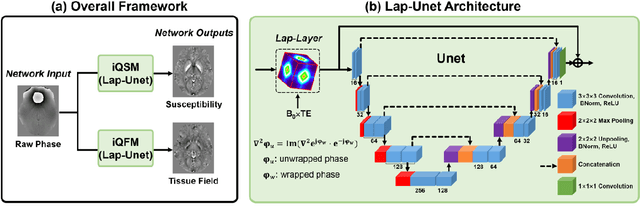

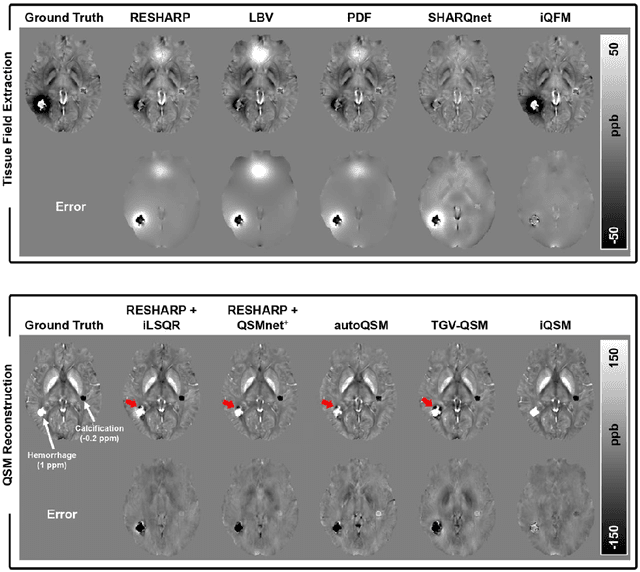

Abstract:Quantitative susceptibility mapping (QSM) is a valuable MRI post-processing technique that quantifies the magnetic susceptibility of body tissue from phase data. However, the traditional QSM reconstruction pipeline involves multiple non-trivial steps, including phase unwrapping, background field removal, and dipole inversion. These intermediate steps not only increase the reconstruction time but amplify noise and errors. This study develops a large-stencil Laplacian preprocessed deep learning-based neural network for near instant quantitative field and susceptibility mapping (i.e., iQFM and iQSM) from raw MR phase data. The proposed iQFM and iQSM methods were compared with established reconstruction pipelines on simulated and in vivo datasets. In addition, experiments on patients with intracranial hemorrhage and multiple sclerosis were also performed to test the generalization of the novel neural networks. The proposed iQFM and iQSM methods yielded comparable results to multi-step methods in healthy subjects while dramatically improving reconstruction accuracies on intracranial hemorrhages with large susceptibilities. The reconstruction time was also substantially shortened from minutes using multi-step methods to only 30 milliseconds using the trained iQFM and iQSM neural networks.
 Add to Chrome
Add to Chrome Add to Firefox
Add to Firefox Add to Edge
Add to Edge